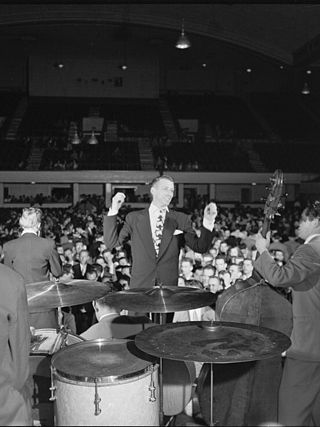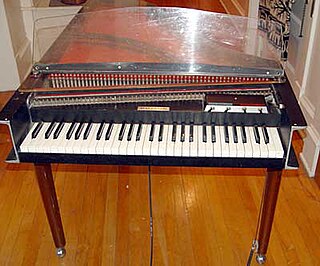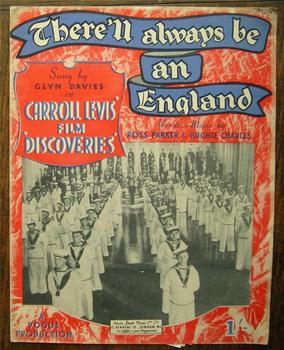New wave is a music genre that encompasses pop-oriented styles from the late 1970s through the 1980s. It is considered a lighter and more melodic "broadening of punk culture" that usually includes the use of synthesizers. It was originally used as a catch-all for the various styles of music that emerged after punk rock, including punk itself. Later, critical consensus favored "new wave" as an umbrella term involving many popular music styles of the era, including power pop, synth-pop, alternative dance, and specific forms of punk that were less abrasive. It may also be viewed as a more accessible counterpart of post-punk.
Punk rock is a music genre that emerged in the mid-1970s. Rooted in 1960s garage rock, punk bands rejected the perceived excesses of mainstream 1970s rock music. They typically produced short, fast-paced songs with hard-edged melodies and singing styles, stripped-down instrumentation, and often shouted political, anti-establishment lyrics. Punk embraces a DIY ethic; many bands self-produce recordings and distribute them through independent record labels.

Psychedelic rock is a rock music genre that is inspired, influenced, or representative of psychedelic culture, which is centered on perception-altering hallucinogenic drugs. The music incorporated new electronic sound effects and recording techniques, extended instrumental solos, and improvisation. Many psychedelic groups differ in style, and the label is often applied spuriously.

Progressive music is music that attempts to expand existing stylistic boundaries associated with specific genres of music. The word comes from the basic concept of "progress", which refers to advancements through accumulation, and is often deployed in the context of distinct genres, with progressive rock being the most notable example. Music that is deemed "progressive" usually synthesizes influences from various cultural domains, such as European art music, Celtic folk, West Indian, or African. It is rooted in the idea of a cultural alternative, and may also be associated with auteur-stars and concept albums, considered traditional structures of the music industry.
Rock is a broad genre of popular music that originated as "rock and roll" in the United States in the late 1940s and early 1950s, developing into a range of different styles from the mid-1960s, particularly in the U.S. and the United Kingdom. It has its roots in 1940s and 1950s rock and roll, a style that drew directly from the blues and rhythm and blues genres of African-American music and from country music. Rock also drew strongly from genres such as electric blues and folk, and incorporated influences from jazz, classical, and other musical styles. For instrumentation, rock has centered on the electric guitar, usually as part of a rock group with electric bass guitar, drums, and one or more singers. Usually, rock is song-based music with a 4
4 time signature using a verse–chorus form, but the genre has become extremely diverse. Like pop music, lyrics often stress romantic love but also address a wide variety of other themes that are frequently social or political. Rock was the most popular genre of music in the U.S. and much of the Western world from the 1950s to the 2010s.
Art rock is a subgenre of rock music that generally reflects a challenging or avant-garde approach to rock, or which makes use of modernist, experimental, or unconventional elements. Art rock aspires to elevate rock from entertainment to an artistic statement, opting for a more experimental and conceptual outlook on music. Influences may be drawn from genres such as experimental music, avant-garde music, classical music, and jazz.
Progressive rock is a broad genre of rock music that primarily developed in the United Kingdom and United States through the mid- to late 1960s, peaking in the early 1970s. Initially termed "progressive pop", the style was an emergence of psychedelic bands who abandoned standard pop traditions in favour of instrumentation and compositional techniques more frequently associated with jazz, folk, or classical music. Additional elements contributed to its "progressive" label: lyrics were more poetic, technology was harnessed for new sounds, music approached the condition of "art", and the studio, rather than the stage, became the focus of musical activity, which often involved creating music for listening rather than dancing.
Gothic rock is a style of rock music that emerged from post-punk in the United Kingdom in the late 1970s. The first post-punk bands which shifted toward dark music with gothic overtones include Siouxsie and the Banshees, Joy Division, Bauhaus, and the Cure.

The Swinging Sixties was a youth-driven cultural revolution that took place in the United Kingdom during the mid-to-late 1960s, emphasising modernity and fun-loving hedonism, with Swinging London denoted as its centre. It saw a flourishing in art, music and fashion, and was symbolised by the city's "pop and fashion exports", such as the Beatles, as the multimedia leaders of the British Invasion of musical acts; the mod and psychedelic subcultures; Mary Quant's miniskirt designs; popular fashion models such as Twiggy and Jean Shrimpton; the iconic status of popular shopping areas such as London's King's Road, Kensington and Carnaby Street; the political activism of the anti-nuclear movement; and the sexual liberation movement.
Shock rock is the combination of rock music or heavy metal music with highly theatrical live performances emphasizing shock value. Performances may include violent or provocative behavior from the artists, the use of attention-grabbing imagery such as costumes, masks, or face paint, or special effects such as pyrotechnics or fake blood. Shock rock also often includes elements of horror.
Pop rock is a rock fusion genre characterized by a strong commercial appeal, with more emphasis on professional songwriting and recording craft, and less emphasis on attitude than standard rock music. Originating in the late 1950s as an alternative to normal rock and roll, early pop rock was influenced by the beat, arrangements, and original style of rock and roll. It may be viewed as a distinct genre field rather than music that overlaps with pop and rock. The detractors of pop rock often deride it as a slick, commercial product and less authentic than rock music.

Baroque pop is a fusion genre that combines rock music with particular elements of classical music. It emerged in the mid 1960s as artists pursued a majestic, orchestral sound and is identifiable for its appropriation of Baroque compositional styles and dramatic or melancholic gestures. Harpsichords figure prominently, while oboes, French horns, and string quartets are also common.

"There'll Always Be an England" is an English patriotic song, written and distributed in the summer of 1939, which became highly popular following the outbreak of the Second World War. It was composed and written by Ross Parker and Hughie Charles. It was recorded in 1939 by Billy Cotton and his Band, whose recording is mentioned on the original 1939 sheet music, and supplied him with a finale for his show for years. A popular version was later recorded by Vera Lynn in 1962.
Neo-psychedelia is a diverse genre of psychedelic music that draws inspiration from the sounds of 1960s psychedelia, either updating or copying the approaches from that era. Originating in the 1970s, it has occasionally seen mainstream pop success but is typically explored within alternative rock scenes. It initially developed as an outgrowth of the British post-punk scene, where it was also known as acid punk. After post-punk, neo-psychedelia flourished into a more widespread and international movement of artists who applied the spirit of psychedelic rock to new sounds and techniques.

John David Robb is an English musician and journalist best known as the bassist and singer for the mid-1980s post-punk band The Membranes.

"I'm Eighteen" is a song by rock band Alice Cooper, first released as a single in November 1970 backed with "Is It My Body". It was the band's first top-forty success—peaking at number 21—and convinced Warner Bros. that Alice Cooper had the commercial potential to release an album. The song and its B-side feature on the band's first major-label album Love It to Death (1971).
Post-punk is a broad genre of rock music that emerged in the late 1970s in the wake of punk rock. Post-punk musicians departed from punk's traditional elements and raw simplicity, instead adopting a broader, more experimental approach that encompassed a variety of avant-garde sensibilities and non-rock influences. Inspired by punk's energy and do it yourself ethic but determined to break from rock cliches, artists experimented with styles like funk, electronic music, jazz, and dance music; the production techniques of dub and disco; and ideas from art and politics, including critical theory, modernist art, cinema and literature. These communities produced independent record labels, visual art, multimedia performances and fanzines.
Art pop is a loosely defined style of pop music influenced by art theories as well as ideas from other art mediums, such as fashion, fine art, cinema, and avant-garde literature. The genre draws on pop art's integration of high and low culture, and emphasizes signs, style, and gesture over personal expression. Art pop musicians may deviate from traditional pop audiences and rock music conventions, instead exploring postmodern approaches and ideas such as pop's status as commercial art, notions of artifice and the self, and questions of historical authenticity.
Experimental rock, also called avant-rock, is a subgenre of rock music that pushes the boundaries of common composition and performance technique or which experiments with the basic elements of the genre. Artists aim to liberate and innovate, with some of the genre's distinguishing characteristics being improvisational performances, avant-garde influences, odd instrumentation, opaque lyrics, unorthodox structures and rhythms, and an underlying rejection of commercial aspirations.
Progressive pop is pop music that attempts to break with the genre's standard formula, or an offshoot of the progressive rock genre that was commonly heard on AM radio in the 1970s and 1980s. It was originally termed for the early progressive rock of the 1960s. Some stylistic features of progressive pop include hooks and earworms, unorthodox or colorful instrumentation, changes in key and rhythm, experiments with larger forms, and unexpected, disruptive, or ironic treatments of past conventions.







